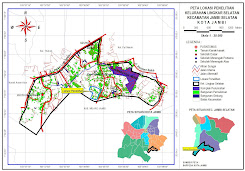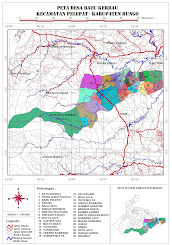The work - based on data collected by NASA's ICESat, Terra, and Aqua satellites -- should help scientists build an inventory of how much carbon the world’s forests store and how fast that carbon cycles through ecosystems and back into the atmosphere. Michael Lefsky of the Colorado State University described his results in the journal Geophysical Research Letters.
 A first-of-its-kind global map shows forest canopy height in shades of green from 0 to 70 meters (230 feet). For any patch of forest, the height shown means that 90 percent or more of the trees in the patch are that tall or taller. Areas without forest are shown in tan. Credit: NASA Earth Observatory/Image by Jesse Allen and Robert Simmon/Based on data from Michael Lefsky.
A first-of-its-kind global map shows forest canopy height in shades of green from 0 to 70 meters (230 feet). For any patch of forest, the height shown means that 90 percent or more of the trees in the patch are that tall or taller. Areas without forest are shown in tan. Credit: NASA Earth Observatory/Image by Jesse Allen and Robert Simmon/Based on data from Michael Lefsky.
The new map shows the world’s tallest forests clustered in the Pacific Northwest of North America and portions of Southeast Asia, while shorter forests are found in broad swaths across northern Canada and Eurasia. The map depicts average height over 5 square kilometers (1.9 square miles) regions), not the maximum heights that any one tree or small patch of trees might attain.
Temperate conifer forests -- which are extremely moist and contain massive trees such as Douglas fir, western hemlock, redwoods, and sequoias--have the tallest canopies, soaring easily above 40 meters (131 feet). In contrast, boreal forests dominated by spruce, fir, pine, and larch had canopies typically less than 20 meters (66 feet). Relatively undisturbed areas in tropical rain forests were about 25 meters (82 feet), roughly the same height as the oak, beeches, and birches of temperate broadleaf forests common in Europe and much of the United States.
Temperate conifer forests -- which are extremely moist and contain massive trees such as Douglas fir, western hemlock, redwoods, and sequoias--have the tallest canopies, soaring easily above 40 meters (131 feet). In contrast, boreal forests dominated by spruce, fir, pine, and larch had canopies typically less than 20 meters (66 feet). Relatively undisturbed areas in tropical rain forests were about 25 meters (82 feet), roughly the same height as the oak, beeches, and birches of temperate broadleaf forests common in Europe and much of the United States.
Where’s the Carbon?
Scientific interest in the new map goes far beyond curiosities about tree height. The map has implications for an ongoing effort to estimate the amount of carbon tied up in Earth’s forests and for explaining what sops up 2 billion tons of “missing” carbon each year.
Humans release about 7 billion tons of carbon annually, mostly in the form of carbon dioxide. Of that, 3 billion tons end up in the atmosphere and 2 billion tons in the ocean. It’s unclear where the last two billion tons of carbon go, though scientists suspect forests capture and store much of it as biomass through photosynthesis.
Scientific interest in the new map goes far beyond curiosities about tree height. The map has implications for an ongoing effort to estimate the amount of carbon tied up in Earth’s forests and for explaining what sops up 2 billion tons of “missing” carbon each year.
Humans release about 7 billion tons of carbon annually, mostly in the form of carbon dioxide. Of that, 3 billion tons end up in the atmosphere and 2 billion tons in the ocean. It’s unclear where the last two billion tons of carbon go, though scientists suspect forests capture and store much of it as biomass through photosynthesis.
European Beech.
Credit: Forestryimages.org/University of West Hungary/Norbert Frank› Larger image
An artist’s representation of ICESat in orbit.
Credit: NASA/Scientific Visualization Studio/Chris Meaney› Larger image
Stand of bristlecone pine on Almahgre Mountain in Colorado.
Credit: Forestryimages.org/USDA Forest Service/Dave Powell› Larger image
There are hints that young forests absorb more carbon than older ones, as do wetter ones, and that large amounts of carbon end up in certain types of soil. But ecologists have only begun to pin down the details as they try to figure out whether the planet can continue to soak up so much of our annual carbon emissions and whether it will continue to do so as climate changes.
“What we really want is a map of above-ground biomass, and the height map helps get us there,” said Richard Houghton, an expert in terrestrial ecosystem science and the deputy director of the Woods Hole Research Center.
One of Lefsky’s colleagues, Sassan Saatchi of NASA’s Jet Propulsion Laboratory, has already started combining the height data with forest inventories to create biomass maps for tropical forests. Complete global inventories of biomass, when they exist, can improve climate models and guide policymakers on how to minimize the human impact on climate with carbon offsets.
More immediately, said University of Maryland remote sensing expert Ralph Dubayah, tree canopy heights can be plugged into models that predict the spread and behavior of fires, as well as ecological models that help biologists understand the suitability of species to specific forests.
“What we really want is a map of above-ground biomass, and the height map helps get us there,” said Richard Houghton, an expert in terrestrial ecosystem science and the deputy director of the Woods Hole Research Center.
One of Lefsky’s colleagues, Sassan Saatchi of NASA’s Jet Propulsion Laboratory, has already started combining the height data with forest inventories to create biomass maps for tropical forests. Complete global inventories of biomass, when they exist, can improve climate models and guide policymakers on how to minimize the human impact on climate with carbon offsets.
More immediately, said University of Maryland remote sensing expert Ralph Dubayah, tree canopy heights can be plugged into models that predict the spread and behavior of fires, as well as ecological models that help biologists understand the suitability of species to specific forests.























